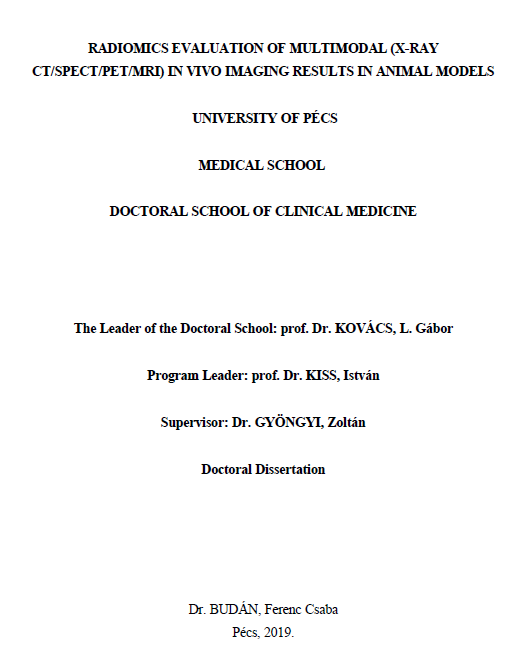Radiomics Evaluation of Multimodal (X-ray CT/SPECT/PET/MRI) in Vivo Imaging Results in Animal Models
Abstract
Multimodal in vivo (X-ray CT/SPECT/PET/MRI) fusion hybrid imaging
provides quantitative, comparable, sensitive, longitudinal and robust data, revealing
important anatomical and functional information, respectively. Radiomics data
handling and evaluation is an approach to increase further the biological value of
information obtained by in vivo imaging. These data can be either morphologic,
results of biochemical reactions, as well as positions of moving organ’s time-related
information. The purpose of radiomics is to increase reliability, precision, accuracy
or robustness of data, or decrease sample number, respectively. The main goal of this
study, was to examine and present a spectrum of radiomics-based imaging in animal
experiments, with the opportunity to adapt it to individual clinical imaging or
monitoring of environmental systems, respectively.
In developed countries the diseases of locomotor- and the respiratory- system
are among the major public health problems. The latter is exacerbated by air
pollution. Apart from that, environmental pollution is continuously growing and it exerts harmful effects on mankind in multifarious ways.
According to the estimations in 2004 in the US leading to approximately 1.5
million fractures, which required bone grafting in ca. 500.000 cases. According to
the WHO in 2012 around 7 million people died as a result of air pollution, including
3.1 million premature deaths caused by indoor and urban outdoor air pollution. In
2016 the air pollution is estimated to reduce the average global life expectancy with
1 year. According to the EPA sulfur dioxide and ground-level ozone precursors
(nitrogen oxides and volatile organic compounds) derived mainly from fuel
combustion are among the most frequent health hazards. Mineral oil and heavy
metals are waste products mostly of municipal, industrial and commercial sectors
and they represent 60% of soil pollution. Among them Cd has the ability to
accumulate with biomagnification process, the excretion of Cd is very slow but its
deleterious effects are severe and multifarious. Therefore possible contamination
with Cd requires to be minimized.
Our research group has established in vivo animal models utilizing radiomicsbased
evaluation to elucidate details of bone formation (bone graft healing) and airpollution
related lung diseases. Also a novel in vivo imaging approach to detect the
effect of soil pollutant Cd in earthworm (Eisenia hortensis and Lumbricus terrestris)
was developed.
Utilizing X-ray CT and MDP SPECT with radiomics-based evaluation
enabled the statistically significant discerning of poly (methyl methacrylate)-based
bone cement graft (PMMA) and albumin coated, sterilized, antigen-extracted freezedried
human bone grafts (HLBC). With X-ray CT reconstructed attenuation
corresponding specific voxel's fractal dimension distribution profile, abstracted their
quantity with histograms, separated to Gaussian-curves with calculated descriptive
parameters, the discerning from each other of a sulfur dioxide gas exposed, of an airdiluted
fresh mainstream cigarette smoke mixed with ozone-air gas mixture treated,
and also of a control group was enabled. Using in vivo earthworms, after proper
immobilization, the early effect of Cd pollution was revealed with FDG PET/MRI
modalities.
Multiple testing with the same animal, combined with radiomics-based
evaluation methods increased cost-effectivity and decreased the necessary sample number of animals, in coherence with the European Union (EU) directive
2010/63/EU on the protection of animals.
The health hazards and diseases investigated in the present work are prime
examples of high individual and societal costs both in quality of life and in financial
sense. The combination of screening, imaging and radiomics-based monitoring offers
and effective opportunity to diagnose early and treat properly the lung or bone
diseases and also to minimize the exposure of environmental pollutions. Moreover
the bone formation evaluation method as well as the attenuation value correlated FD
distribution pattern analysis of the chest X-ray CT may be even adapted into clinical
practice to monitor surgical, pharmaceutical, and physical therapies. The developed
earthworm test system may enhance the required strict environmental monitoring.
This can even underpin decisions to decrease Cd concentration with the extensive
and costly soil replacement intervention, if it is necessary.
The thesis also leads the way to further more widespread studies both in
clinical prevention and environmental protection enhanced by radiomics evaluation
methods of image data.

